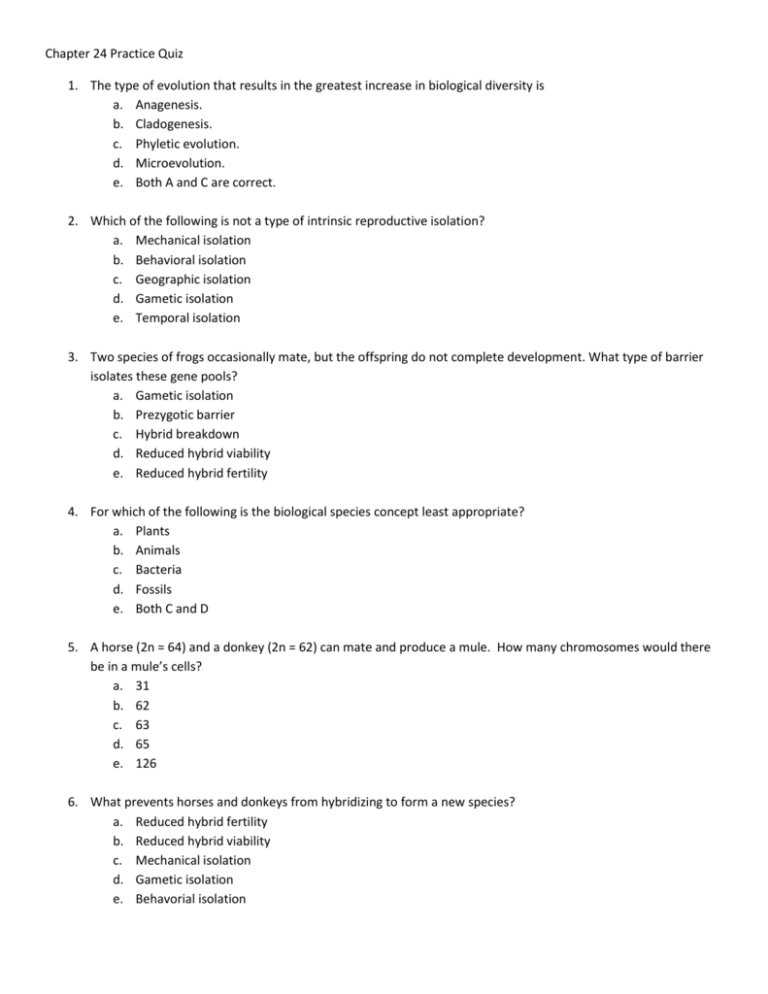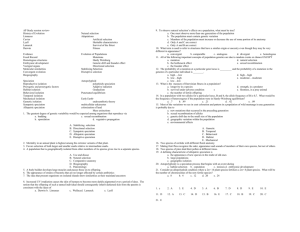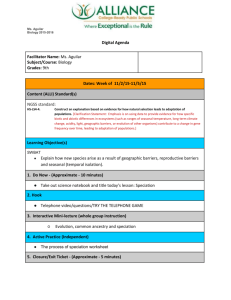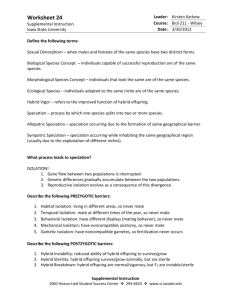Evolution & Speciation Practice Quiz
advertisement

Chapter 24 Practice Quiz 1. The type of evolution that results in the greatest increase in biological diversity is a. Anagenesis. b. Cladogenesis. c. Phyletic evolution. d. Microevolution. e. Both A and C are correct. 2. Which of the following is not a type of intrinsic reproductive isolation? a. Mechanical isolation b. Behavioral isolation c. Geographic isolation d. Gametic isolation e. Temporal isolation 3. Two species of frogs occasionally mate, but the offspring do not complete development. What type of barrier isolates these gene pools? a. Gametic isolation b. Prezygotic barrier c. Hybrid breakdown d. Reduced hybrid viability e. Reduced hybrid fertility 4. For which of the following is the biological species concept least appropriate? a. Plants b. Animals c. Bacteria d. Fossils e. Both C and D 5. A horse (2n = 64) and a donkey (2n = 62) can mate and produce a mule. How many chromosomes would there be in a mule’s cells? a. 31 b. 62 c. 63 d. 65 e. 126 6. What prevents horses and donkeys from hybridizing to form a new species? a. Reduced hybrid fertility b. Reduced hybrid viability c. Mechanical isolation d. Gametic isolation e. Behavorial isolation 7. Which of the following species concepts identifies species based on their similarities resulting from their unique niche or role in the environment? a. Biological b. Ecological c. Paleontological d. Morphological e. Phylogenetic 8. Allopatric speciation is more likely to occur when an isolated population a. Is large and thus has more genetic variation. b. Is reintroduced to its original homeland. c. Is small and exposed to different selection pressures in its new habitat. d. Inhabits an island close to its parent species’ mainland. e. All of the above contribute to allopatric speciation. 9. A tetraploid plant species (with four identical sets of chromosomes) is probably the result of a. Allopolyploidy. b. Autopolyploidy. c. Hybridization and nondisjucntion. d. Allopatric speciation. e. A and C. 10. All of the following would help to identify sister species except a. Genetic analysis. b. Test for reproductive incompatibility. c. Phylogenetic analysis d. Morphological comparisons. e. All of the above are essential to distinguishing sister species. 11. There are 28 morphologically diverse species of a group of sunflowers called silverswords found on the Hawaiian Archipelago. These species are an example of a. A geographical cline. b. Adaptive radiation. c. Allopolyploidy. d. The bottleneck effect. e. Sympatric speciation. 12. Which of the following is descriptive of the punctuated equilibrium model? a. Long periods of stasis are punctuated by episodes of relatively rapid speciation and change. b. Microevolution is the driving force of speciation. c. Most rapid speciation events involve polyploidy in plants. d. Evolution occurs gradually as the environment gradually changes. e. In the framework of geologic time periods, speciation events occur very slowly and the equilibrium of species is punctuated by frequent extinctions. 13. A new plant species C formed from hybridization of species A (2n = 18) with species B (2n = 12) would probably produce gametes with a chromosome number of a. 12. b. 15. c. 18. d. 30. e. 60. 14. Which of the following would not contribute to allopatric speciation? a. Geographic speciation b. Genetic drift c. Gene flow d. Different selection pressures e. Founder effect 15. What is meant by the concept of species selection? a. Reproductive isolating mechanisms (both prezygotic and postzygotic) are responsible for maintaining the integrity of individual species. b. Characteristics that increase the probability of selection as a mate or success in competition for mates will be selected for and increase in frequency in a population. c. The species that last the longest and speciate the most often determine the direction of evolutionary trends. d. A new species accumulates most of its unique features as it originates and then maintains long periods of stasis in body form. e. The colonization of new and diverse habitats can lead to the adaptive radiation of numerous species. 16. Allometric growth a. Results in paedomorphosis. b. Results in an evolutionary trend of increasing body size. c. Results from differences in the locations of expression of Hox genes and thus the placement of body parts. d. Is usually associated with polyploidy in plants. e. Is the relative differences in growth rates of different body parts. 17. The evolution of lungs from the swim bladder of ancestral fish is an example of a. Heterochrony. b. Paedomorphosis. c. Exaptation. d. Changes in homeotic gene expression. e. Punctuated equilibrium. 18. Which of the following is thought to be a critical event in the evolution of vertebrates from an invertebrate ancestor? a. Exaptation of body segments to vertebrae b. Duplication of the Hox complex (homeotic genes) c. Allometric growth of tail segements d. Allopatric speciation e. Sympatric speciation 19. A botanist identifies a new species of plant that has 32 chromosomes. It grows in the same habitat with three similar species: species A (2n = 14), species B (2n = 16), and species C (2n = 18). Suggest a possible speciation mechanism for the new species. a. Allopatric divergence by development of a reproductive isolating mechanism b. Change in a key developmental gene that causes the plants to flower at different times c. Autopolyploidy, perhaps due to a nondisjunction in the formation of gametes in species B d. Allopolyploidy, a hybrid formed from specis A and C e. Either C or D could account for the formation of this new plant species 20. Which concept of species would be most useful to a field biologist identifying new species in a tropical rain forest? a. Biological b. Ecological c. Paleontological d. Morphological e. Phylogenetic









